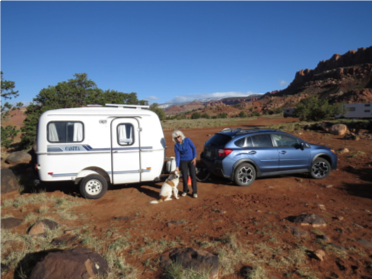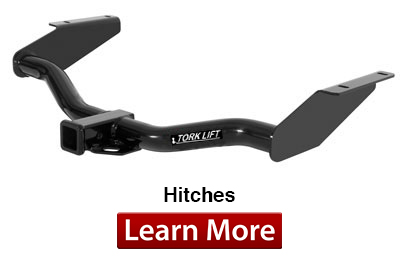Trailer Hitch Receiver Sizes

Are you planning on towing? Know the best receiver size for your application!
Do you plan on camping this summer and want to bring some of your bigger toys with you including ATVs, motorcycles and more? If so, then you’re going to need a way to bring your extra cargo. If the bed of your truck is full, revert to towing something behind your vehicle in order to bring all your gear. While it may seem intimidating, hitches are easier than they look – including understanding the different receiver sizes.
1 ¼-inch X 1 ¼-inch
Typically, this receiver size is available on Class I and Class II hitches. These 1 ¼-inch hitches are meant for lighter weight accessories and towing. Class I hitches are typically rated at up to 200 pounds tongue weight and 2,000 pounds towing weight and are used with compact cars, sedans and some small SUVs.
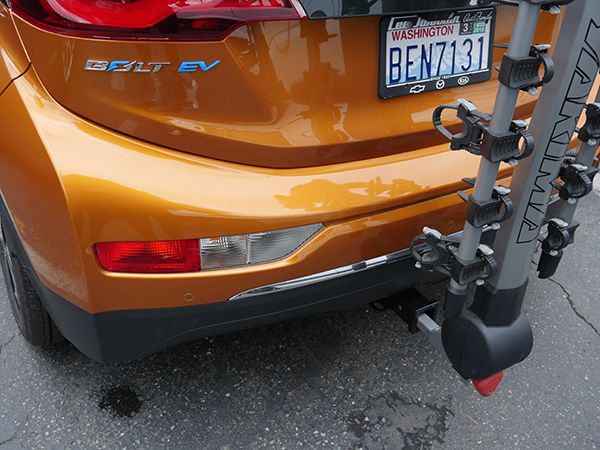
Example of a 1 1/4" with a bike rack installed in the receiver.
Class II hitches are rated around 350 pounds tongue weight and up to 3,500 pounds towing weight and are used with sedans and small SUVs. Most Class I hitches will offer 1 ¼-inch and most Class II hitches will have both 1 ¼-inch and 2-inch options available.
- Examples of what you can use/tow with a 1 ¼-inch receiver:
- Bike rack
- Cargo trays
- Small tent camper
- Jet skis
2-inch X 2-inch
Typically, this receiver size is available on Class III to Class V hitches. These 2-inch hitches are made for heavier duty towing depending on what the hitch weight ratings are from the manufacturer. Class III hitches are usually rated at around 500/600 pounds tongue weight and 5,000 pounds towing weight. Class V hitches can be rated up to 1,700 pounds tongue weight and 20,000 pounds towing weight. These hitches are used with sedans, some compact cars, SUVs and trucks.
Because of the nature of some of the heavier duty towing that can be accomplished with a 2-inch X 2-inch receiver hitch, many of these hitches not only have their original weight ratings and will also be rated for weight distribution to maximize the full weight carrying potential of the trailer hitch.
- Examples of what you can use/tow with a 2-inch receiver:
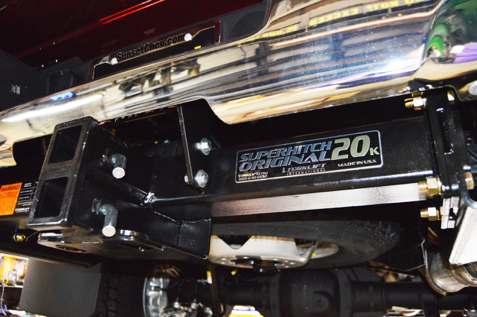
An example of a heavier-duty 2" x 2" hitch, the SuperHitch original trailer hitch.
- Bike rack
- Cargo trays
- Small tent camper
- Jet skis
- Utility trailers
- Small travel trailers (Class IV and above)
- Toy haulers (Class IV and above)
- Large boats (Class IV and above)
Due to how many trailer classes that utilize 2-inch receivers, the most amount of accessories exist for this receiver size – that gives you many options available for the accessories you want to use with your trailer hitch.
2 ½-inch X 2 ½-inch
The 2 ½-inch x 2 ½-inch hitches are also a part of the Class V hitches and their weight ratings that are listed above, but usually on the higher scale of the ratings. These 2 ½-inch receivers are meant for incredibly heavy-duty towing. Manufactured to handle extreme capacities, so they also come with weight distribution weight ratings for towing heavy loads.
- Examples of what you can use/tow with a 2 ½-inch receiver:
- Large trailers
- Equipment haulers
- Multi-car trailers
- Large boats
- Toy haulers
- Large travel trailers
- Utility trailer
3-inch X 3-inch
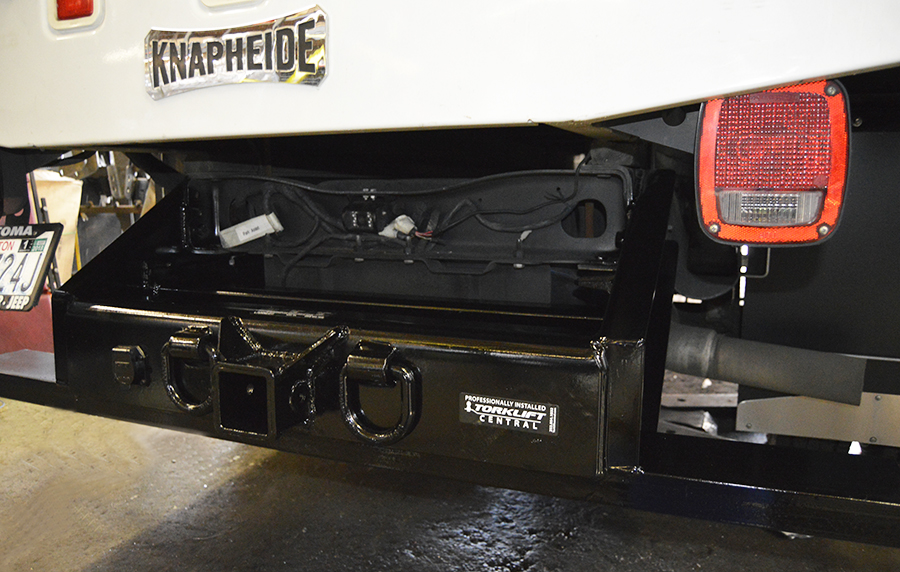
A custom 3" receiver installed at Torklift Central.
The big kahuna! The biggest receiver sizes available. Most of these hitches need to be custom made, such as at Torklift Central because many manufacturers only go up to 2-inch or 2 ½-inch receiver sizes. Trailer hitches that are 3-inch are for extremely heavy-duty towing.
Typically, the 3-inch receivers are rated up to 4,000 pounds tongue weight and 25,000 to 30,000 pounds towing weight rating and are used with large trucks, utility vehicles and work vehicles.
- Examples of what you can use/tow with a 3-inch receiver
- Large trailers
- Equipment haulers
- Multi-car trailers
- Large boats
- Toy haulers
- Large travel trailers
- Utility trailer
Hitch Accessories
Have 1 ¼-inch accessories but only have a 2-inch receiver available for your vehicle? What can you do? Luckily there is an option for you – hitch adapters. Their sole purpose is to convert whatever receiver size you have installed into another receiver size. The main adapters that are made are for converting 1 ¼-inch receivers to 2-inch receiver and vice versa. Other adapters are also able to convert 2-inch receiver to 2 ½-inch receiver and vice versa.
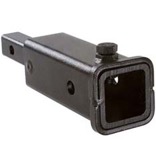
Example of a hitch receiver adapter.
For safety reasons, we suggest going with a bigger receiver to a smaller receiver if at all possible with a hitch adapter. For example, using an adapter to convert a 2-inch receiver down to a 1 ¼-inch receiver. Simply insert the hitch adapter into the receiver, and the accessory into the hitch adapter. It’s usually safer going from a larger receiver to a smaller receiver, but both options are available. However, be very careful to follow all capacities as the 1 ¼-inch hitches carry lower capacities and adapters often reduce them further.
While there are products, such as the hitch adapter, to help you change your receiver size, many hitch accessories are designed to maximize the weight capacity of the hitches they’re built for. It’s very important to always stay within your hitches and vehicles weight capacities.
If you are interested in using a bike rack, towing a trailer, loading up a cargo tray or more with a new trailer hitch, contact us today! We offer many standard options as well as custom hitch receivers to fit all your needs. Use the information below and we’d love to get you set up with an appointment to install a tow hitch today.
Torklift Central
315 Central Ave N Kent, WA 98032
[email protected]
877-373-9195
www.torkliftcentral.com
Written by: Kerstin Stokes

As a graduate from the College of Idaho with a B.A. in both History and Art, Kerstin has found her passion for writing and marketing. She enjoys looking up tasty recipes, spoiling her cat Clio and daydreaming about future travels.

